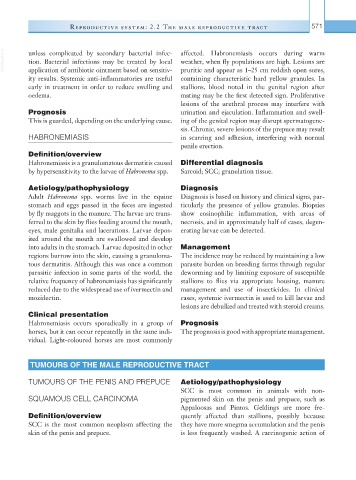Page 596 - Equine Clinical Medicine, Surgery and Reproduction, 2nd Edition
P. 596
Reproductive system: 2.2 The male reproductive tr act 571
VetBooks.ir unless complicated by secondary bacterial infec- affected. Habronemiasis occurs during warm
weather, when fly populations are high. Lesions are
tion. Bacterial infections may be treated by local
application of antibiotic ointment based on sensitiv-
containing characteristic hard yellow granules. In
ity results. Systemic anti-inflammatories are useful pruritic and appear as 1–25 cm reddish open sores,
early in treatment in order to reduce swelling and stallions, blood noted in the genital region after
oedema. mating may be the first detected sign. Proliferative
lesions of the urethral process may interfere with
Prognosis urination and ejaculation. Inflammation and swell-
This is guarded, depending on the underlying cause. ing of the genital region may disrupt spermatogene-
sis. Chronic, severe lesions of the prepuce may result
HABRONEMIASIS in scarring and adhesion, interfering with normal
penile erection.
Definition/overview
Habronemiasis is a granulomatous dermatitis caused Differential diagnosis
by hypersensitivity to the larvae of Habronema spp. Sarcoid; SCC; granulation tissue.
Aetiology/pathophysiology Diagnosis
Adult Habronema spp. worms live in the equine Diagnosis is based on history and clinical signs, par-
stomach and eggs passed in the feces are ingested ticularly the presence of yellow granules. Biopsies
by fly maggots in the manure. The larvae are trans- show eosinophilic inflammation, with areas of
ferred to the skin by flies feeding around the mouth, necrosis, and in approximately half of cases, degen-
eyes, male genitalia and lacerations. Larvae depos- erating larvae can be detected.
ited around the mouth are swallowed and develop
into adults in the stomach. Larvae deposited in other Management
regions burrow into the skin, causing a granuloma- The incidence may be reduced by maintaining a low
tous dermatitis. Although this was once a common parasite burden on breeding farms through regular
parasitic infection in some parts of the world, the deworming and by limiting exposure of susceptible
relative frequency of habronemiasis has significantly stallions to flies via appropriate housing, manure
reduced due to the widespread use of ivermectin and management and use of insecticides. In clinical
moxidectin. cases, systemic ivermectin is used to kill larvae and
lesions are debulked and treated with steroid creams.
Clinical presentation
Habronemiasis occurs sporadically in a group of Prognosis
horses, but it can occur repeatedly in the same indi- The prognosis is good with appropriate management.
vidual. Light-coloured horses are most commonly
TUMOURS OF THE MALE REPRODUCTIVE TRACT
TUMOURS OF THE PENIS AND PREPUCE Aetiology/pathophysiology
SCC is most common in animals with non-
SQUAMOUS CELL CARCINOMA pigmented skin on the penis and prepuce, such as
Appaloosas and Pintos. Geldings are more fre-
Definition/overview quently affected than stallions, possibly because
SCC is the most common neoplasm affecting the they have more smegma accumulation and the penis
skin of the penis and prepuce. is less frequently washed. A carcinogenic action of

